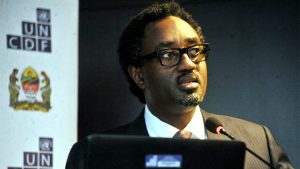UNCDF: Revolutionising International Municipal Finance is Focus of Bid to Tackle Climate Change and Open Global Markets

Author: Jaffer Machano
“They have been drivers of progress throughout history, and now – as the knowledge economy takes full flight – they are poised to play a leading role in addressing the challenges of the 21st Century,” wrote former Mayor of New York City Michael Bloomberg in a piece he penned in 2015.
Bloomberg was referencing the remarkable power of cities as drivers of innovative and critical solutions, most notably to the threat of climate change. He also correctly acknowledges one of the key barriers preventing investments in climate resiliency and sustainability, especially in the developing world. “To borrow money in the capital markets, for instance, cities need a credit rating; outside of the United States and Europe,” he wrote, “however, many lack them.”
This one sentence speaks to a larger, undeniable reality: that the kind of global financial system that accommodates local government finance in the developing world simply does not exist
This is why the United Nations Capital Development Fund (UNCDF) has partnered with United Cities and Local Government (UCLG) and the Global Fund for Cities Development (FMDV) to create the first international fund focused on enabling access to municipal finance, which will have a target starting value of $250 million.
“What cannot be overlooked is the fact that cities in developing countries are effectively blocked from capital markets.”
But that is just one prong of the reform effort that began in earnest last year at the High-Level Meeting On Municipal Finance in Malaga, Spain. The second prong involves advocating and advancing a comprehensive strategy that would fundamentally change investment decision-making as it relates to municipal finance—from calling on central governments to ensure fair and reliable national transfers to highlighting investments in intermediary cities and advocating for change in the international financial architecture to disaggregate national and subnational debt.
To understand the motivation for this bid for global financial reform, it is best to start with an appreciation of the exact challenge Mayor Bloomberg spoke of.
Frozen Out
Much of the international conversation regarding local economic development or municipal finance has traditionally focused on fiscal centralisation; specifically, how it drains subnational governments of revenue and growth. That is an essential point. A joint report published by the OECD and UCLG found that subnational tax revenues as a percentage of GDP in federal countries was nearly three times higher than those revenues in more centralised countries. For those fortunate local governments, the political autonomy they possess in a federal system also comes with fiscal capability and better service delivery to the community. For local governments in centralised countries, the opposite is the case.
What cannot be overlooked is the fact that cities in developing countries are effectively blocked from capital markets. According to the World Bank’s Low Carbon Liveable Cities Initiative, only 4% of the 500 largest cities in developing countries are considered “investment grade” by international standards. This data point is more disheartening when just $1 invested in creditworthiness can help mobilise $100 of greater investment, according to the World Bank. From a practical standpoint, municipal governments are unable to procure the infrastructure projects, place bankable investments in the pipeline, or explore financing mechanisms to finance climate resiliency projects – a fundamental reason for the climate resiliency infrastructure divide between developed and developing countries.
To focus solely on climate resiliency, despite its enormous importance, is to have an incomplete appreciation for what is at stake. Ensuring that cities and communities are sustainable encompasses far more than SDG 11 of the Sustainable Development Goals. Practically every goal under the SDGs runs through sustainable cities, from clean water and sanitation to affordable clean energy, to sustainable goals relating to industry, innovation and infrastructure.
Municipal finance will also be critical to achieving the kind of sustainable urban development necessary to end poverty. To support future job creation in the context of the Fourth Industrial Revolution, it is necessary to create – by 2030 – between 470 million and 600 million jobs. Ensuring that this job creation is not consolidated to the developed world, thus becoming a driver of global wealth inequity and poverty, requires local development in Least Developed Countries (LDCs). And that requires the global financial system we seek. Not the one that we have.
The Ten-Year Old Lesson
Ten years ago this April, the G-20 unveiled an intervention package intended to confront the worst economic crisis since the Great Depression of the 1930s. A core element of the package was leveraging capital of more than a trillion dollars to drive global trade, spur demand, and unlock credit. Another element involved efforts to change the decision-making environment so that the choices and policies that led to grave economic shocks, even if they were Black Swan events, would rarely be implemented again – from increasing capital requirements to implementing domestic and international oversight.
It doesn’t take the threat of the dissolution of global credit markets to draw an invaluable lesson from the G-20’s response. If global financial reform is necessary, that reform effort needs to have two prongs: one focusing on the systems that enable the access of capital, and the other on the decision-making ecosystem that drives capital flows.
The first prong emerged during last year’s High-Level Meeting on Municipal Finance, with the decision to create the first international fund for municipal investment – a fund jointly designed by United Cities and Local Government, the Global Fund for Cities Development, and the UNCDF.
The core of the fund’s work will be providing capital to bankable projects, marrying international capital with the commercial, actionable intelligence that comes from local governments’ awareness of local needs. The fund will also rely on innovative financing tools, including blended finance where we would leverage concessionary capital to catalyse private sector investment. And at this year’s High-Level Conference in Malaga, the investment manager who will independently establish, structure, fundraise and manage the prospectively $250 million fund will be named. The fund will also act as a catalyst in attracting investors for worthy commercial projects in cities within developing markets. This effort will support the reforms needed to further deepen the access to capital by cities in these parts of the world.
The other prong involves changing the decision-making environment by changing the perceptions of international finance actors – from governments and institutional investors to organisations and enterprise philanthropists. The goal is to get these actors to understand how investment in local governments can advance global interests, as well as deliver real return on investment. That is why we are advocating for and working to enact other policy measures based on recommendations from last year’s conference in Malaga.
One approach is utilising the tools of financial innovation. Luckily, there are a variety of innovative financing tools at our disposal: promoting municipal investment bonds as financial intermediaries, with commercial guarantees that can raise capital; influencing asset allocation strategies of institutional investors; and blended finance vehicles. These tools will go a long way towards minimising risk and catalysing greater investment at the local level.
Another approach is to increase and sharpen the investment focus on intermediary or secondary cities. While the attention on municipal investment for sustainable development has increased, much of that focus has been on megacities with populations of a million or more. As a result, intermediary or secondary cities needing support to build legal frameworks, administrative capacity, and access to capital markets are overlooked. That is despite the fact that many of these cities feature large, fully formed economies. One reason these secondary cities have been ignored by investors is a simple misunderstanding of risk, thinking that these cities are too risky.
Finally, and perhaps most importantly, we are advocating for a dramatic change in public accounting when it comes to debt, specifically to address the challenge Bloomberg outlined. Developed economies are able to separate different types of debt for the purposes of their creditworthiness profile. But developing markets do not have that luxury. That means that municipal governments must carry the weight of national debt as their creditworthiness is assessed. Our response is to address public accounting on national debt, relative to subnational debt; to seek ways to adequately account for municipal debt independent of national debt, especially when local governments borrow in local currency. This will go a long way towards creating a more level playing field for localities in LDCs, while providing would-be investors and donors a better understanding of the potential risks and returns on their investments.
Financing Progress; Advancing History
There is one source of optimism that fuels our work to reform the global financial system. Despite the challenging environment relating to municipal finance, interactions with investors and donors have shown that they are interested in subnational investment at the international level. Most investors understand the need to invest in subnational debt. The overriding question investors and donors have is not “why invest”, but “how can I invest?” Our work intends to offer a strong answer to both questions.
Our optimism, however, stands closely with our sense of urgency. The adverse consequences we risk experiencing in the future are as acute and as grave as the consequences associated with 2008 and 2009. There is no path to achieving practically every worthy global interest we have – scaling climate resiliency, eliminating poverty, and continuing economic growth – that does not run through local finance.
A new global financial system to support local finance will ensure that cities continue their tradition of driving progress throughout history. In the process, those cities will be positioned to do more than be a part of 21st Century history. They will be able to write it.
About UNCDF
UNCDF is the UN’s capital investment agency for the world’s 48 least developed countries. It creates new opportunities for poor people and their small businesses by increasing access to microfinance and investment capital. UNCDF focuses on Africa and the poorest countries of Asia, with a special commitment to countries emerging from conflict or crisis. It provides seed capital – grants and loans – and technical support to help microfinance institutions reach more poor households and small businesses, and local governments finance the capital investments – water systems, feeder roads, schools, irrigation schemes – that will improve poor peoples’ lives. UNCDF programmes help to empower women, and are designed to catalyze larger capital flows from the private sector, national governments and development partners, for maximum impact toward the Millennium Development Goals. For more information, please visit www.uncdf.org and subscribe for news, follow @UNCDF on Twitter and UN Capital Development Fund on Facebook.
You may have an interest in also reading…
Fruitful Relationships: Clearing and Settlement in Brazil
By Flavio Peppe As Brazil’s economy has grown so has its financial markets. The volume of equities traded on the
“The Entrepreneur” – A Sense of Balance
By Mona Vyas From the moment of conception to the surrender of the last breath, entrepreneurs have to fight innumerable
EY: Haunted by Phantom Income and at the Mercy of Economic Patterns — Inflation Distorts World Tax Systems
Recent IMF data show developed economies are running at an annual inflation rate of three to 10 percent. Some eastern



















































































